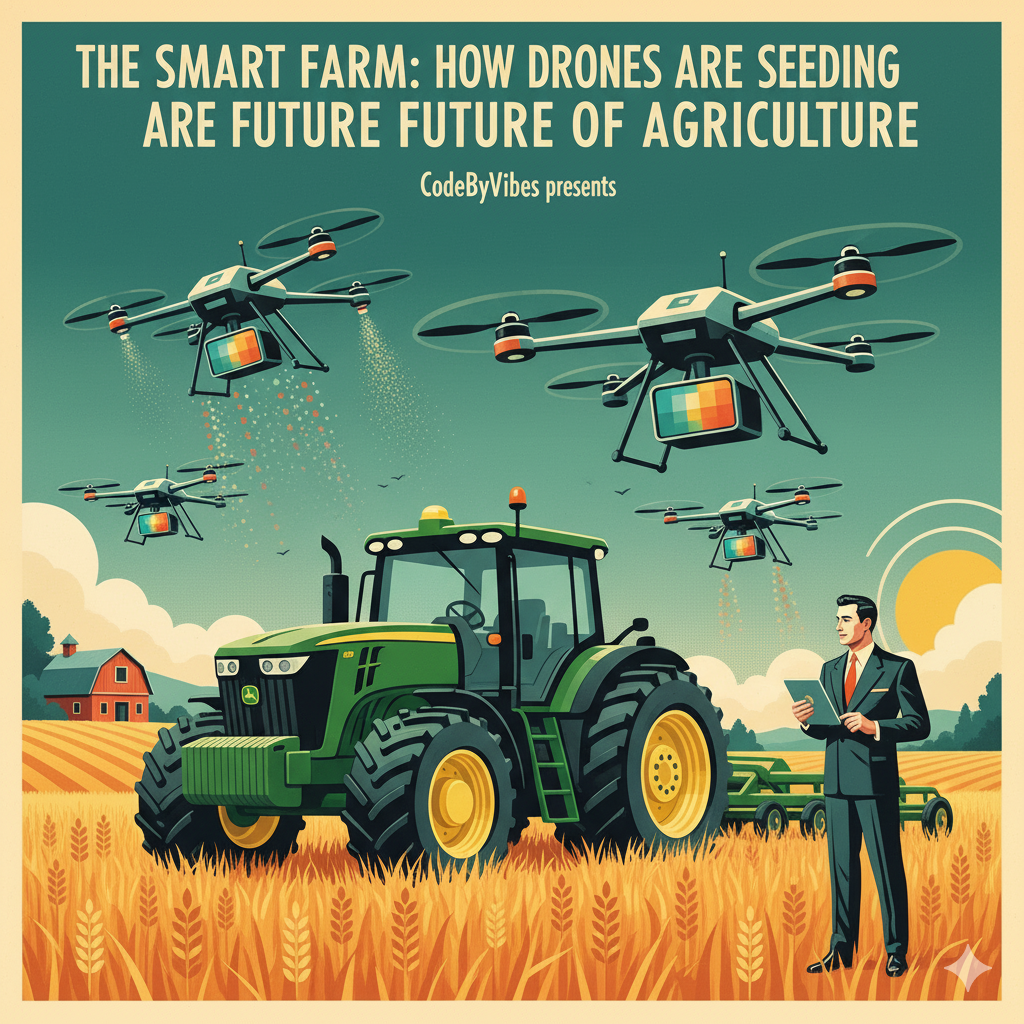The Smart Farm: How Drones Are Seeding the Future of Agriculture
The farmer of the future might be a drone pilot. In what is being called the Fourth Agricultural Revolution, or “Agriculture 4.0,” technology is fundamentally reshaping one of humanity’s oldest and most essential industries. We are moving beyond simple mechanization and the Green Revolution’s chemical advancements into an era of data-driven, autonomous, and highly precise farming. At the forefront of this transformation are Unmanned Aerial Vehicles (UAVs), or drones. These sophisticated machines are becoming indispensable tools, allowing companies like John Deere and innovative farmers worldwide to monitor crop health with incredible detail, apply resources with surgical accuracy, and boost yields while simultaneously reducing environmental impact.
The Modern Farmer’s Evolving Landscape
Today’s agricultural industry stands at a critical juncture, facing a complex convergence of challenges. The primary pressure is the need to feed a global population projected to reach nearly 10 billion by 2050. This must be accomplished on finite arable land and with increasing resource constraints. Compounding this is a significant labor shortage; the average age of a farmer in the United States is 55, and the physically demanding nature of the work has made it difficult to attract younger generations who are often drawn to urban centers.
Simultaneously, farmers are on the front lines of climate change, contending with unpredictable weather patterns, from prolonged droughts to extreme rainfall. There is also a growing regulatory and consumer demand for more sustainable practices that protect soil health, conserve water, and reduce chemical runoff. These factors create an urgent need for solutions that can dramatically increase efficiency and sustainability.
Drones: The Eyes in the Sky for Precision Agriculture
Enter the drone, a transformative tool in the modern agricultural arsenal. These UAVs, when equipped with advanced technologies like multispectral and thermal sensors, provide farmers with an unparalleled, data-rich view of their fields. This capability is the cornerstone of precision agriculture, an approach that uses data to manage crops on a plant-by-plant basis rather than a field-by-field one.
Multispectral sensors capture light from specific bands across the electromagnetic spectrum, revealing subtle variations in plant health that are invisible to the naked eye. This data is used to generate vegetation indices like NDVI (Normalized Difference Vegetation Index), which serves as a vital sign for crops, indicating their vigor, biomass, and nutrient status. By analyzing these high-resolution maps, farmers can:
- Proactively Monitor Crop Health: Drones can identify early signs of stress caused by nutrient deficiencies, pests, or diseases, often days or weeks before they become visible. This allows for early, targeted intervention, preventing widespread damage and crop loss.
- Optimize Fertilizer and Water Use: By creating Variable Rate Application (VRA) maps from drone data, farmers can apply fertilizer precisely where it is most needed and in the exact amount required. Similarly, thermal imaging can pinpoint areas of water stress, leading to more efficient irrigation and significant water savings.
- Execute Targeted Weed and Pest Control: Larger sprayer drones can be dispatched to specific GPS coordinates identified by scouting drones. This allows for “spot spraying” of herbicides and pesticides, drastically reducing the overall volume of chemicals applied to a field, which is better for the environment and the farmer’s budget.
John Deere’s Vision for an Autonomous, Connected Farm
Leading this agricultural transformation is John Deere, a company that has evolved from a steel plow manufacturer into a high-tech powerhouse. John Deere is developing sophisticated solutions that integrate drones, AI, and robotics into a seamless farm ecosystem. Their well-known AutoTrac technology enables tractors to steer themselves with sub-inch accuracy, reducing operator fatigue and optimizing field passes. The company’s ambitious goal is to achieve 100% autonomous farming by 2030, a vision that includes machines capable of performing entire tasks without human intervention.
This commitment to “Tech with a purpose” is embodied in several key areas:
- The John Deere Operations Center: This cloud-based platform acts as a central command hub, aggregating and analyzing vast amounts of data from connected machines—including tractors, combines, and drones—across over 330 million acres of farmland. This provides farmers with actionable insights for every stage of the growing season.
- See & Spray™ Technology: A prime example of their AI in action, this system uses dozens of cameras and powerful processors on a sprayer to distinguish between crops and weeds in real-time. It then activates individual nozzles to spray only the weeds, reducing herbicide use by over two-thirds compared to broadcast spraying.
- Inter-Machine Communication: John Deere’s vision includes machines that communicate with each other. For instance, two combines in the same field can share real-time data on grain levels and harvested areas, allowing them to work in perfect concert and optimize the logistics of unloading grain into a cart.
Seeding a Sustainable and Tech-Driven Future
The “Smart Farm” is not a distant concept; it is rapidly becoming the new standard. The integration of drones, AI, and robotics is fundamentally reshaping how we grow food, making agriculture more productive and environmentally responsible. The impact extends beyond the field, creating a ripple effect across the industry.
This technological revolution is making agriculture an exciting, high-tech field, attracting a new generation of talent interested in data science, robotics, and sustainable systems. The new roles on the farm are just as likely to be data analyst or drone fleet manager as tractor driver. As rural connectivity improves, spurred by innovations in satellite communications, the capabilities of these connected machines will only grow.
By embracing these technologies, farmers are not just cultivating crops; they are cultivating a more resilient and efficient food system. The convergence of centuries of agricultural knowledge with cutting-edge technology promises to ensure global food security and a more sustainable planet for generations to come.
Sources
- Bloomberg Originals: “How Robots and AI Are Changing Farming” – https://www.youtube.com/watch?v=A4WUNvwqxIs
- CES: “Futuristic Farming: John Deere Ups Yields with AI, Robotics” – https://www.youtube.com/watch?v=kCAy8-57pHo
Recommended Reading
- The Dawn of Driverless Delivery: Is Aurora Steering the Future of Freight?
- Relevance: Think self-driving tractors are cool? Wait ’til you see self-driving trucks! 🚚 This piece explores how the same AI magic transforming farms is also about to hit the open road. It’s the robot revolution, but for logistics! 🤖
- The Final Frontier’s New Landlords: Who Will Build the Next ISS?
Relevance: From smart farms to space stations! 🚀 This article explores how private companies are building the next generation of infrastructure in orbit. It’s the same tech-fueled ambition—using awesome engineering to tackle huge challenges, whether it’s feeding the planet 🌎 or living among the stars. ✨

